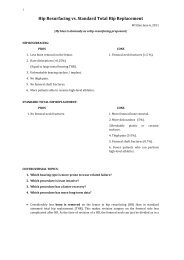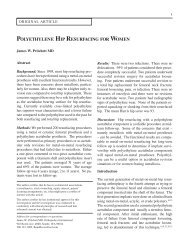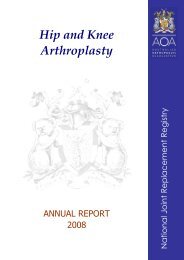Birmingham H ip Resurfacing v ersus C onserv e Plus M etal-on-M ...
Birmingham H ip Resurfacing v ersus C onserv e Plus M etal-on-M ...
Birmingham H ip Resurfacing v ersus C onserv e Plus M etal-on-M ...
Create successful ePaper yourself
Turn your PDF publications into a flip-book with our unique Google optimized e-Paper software.
Coverage Angle<br />
The alpha angle or coverage angle is a measure that is design specific and is the protecti<strong>on</strong>, coverage of the socket <strong>on</strong> the ball of the m<str<strong>on</strong>g>etal</str<strong>on</strong>g>-<strong>on</strong>-m<str<strong>on</strong>g>etal</str<strong>on</strong>g><br />
joint. In the old m<str<strong>on</strong>g>etal</str<strong>on</strong>g>-<strong>on</strong>-plastic joint this was 180 degrees or a full hemisphere, in m<str<strong>on</strong>g>etal</str<strong>on</strong>g>-<strong>on</strong>-m<str<strong>on</strong>g>etal</str<strong>on</strong>g> it became less because of risk of impingement (two<br />
parts damaging each other with range of movement).<br />
Copyright Dr. Koen De Smet<br />
Because of this smaller coverage, the angle of implantati<strong>on</strong> of the cup<br />
becomes more important.<br />
The coverage of the ball decreases with:<br />
8<br />
- higher abducti<strong>on</strong> of the cup<br />
- smaller size<br />
- smaller alfa angle of the prosthesis.<br />
Smaller coverage means a smaller surface of the socket is available to cover the ball resulting in<br />
higher wear of the m<str<strong>on</strong>g>etal</str<strong>on</strong>g>-<strong>on</strong>-m<str<strong>on</strong>g>etal</str<strong>on</strong>g> joint.<br />
The importance of these three aspects (cup abducti<strong>on</strong> angle β, head diameter and head coverage angle α) and their influence <strong>on</strong> wear of the prosthesis<br />
is dem<strong>on</strong>strated in figure 10. One can see from this graph that a C<str<strong>on</strong>g><strong>on</strong>serv</str<strong>on</strong>g>e <str<strong>on</strong>g>Plus</str<strong>on</strong>g> device with 170 degree head coverage angle α can withstand<br />
steeper cup placement before encountering an edge-loading c<strong>on</strong>diti<strong>on</strong> than the BHR device with a maximum of 164 degree head coverage angle,<br />
this difference being more pr<strong>on</strong>ounced with smaller diameter comp<strong>on</strong>ents (blue dots). This is also the case for the ASR device (Articular Surface<br />
Replacement)(DePuy J&J) which has even smaller head coverage angle than that of the BHR (black circles).<br />
Cup coverage angle α<br />
Femoral head diameter (mm)<br />
Fig 9. Alpha angle as a functi<strong>on</strong> of socket radius.<br />
Fig 10. Graph showing the relati<strong>on</strong>sh<str<strong>on</strong>g>ip</str<strong>on</strong>g> between the head coverage angle alpha, cup abducti<strong>on</strong> angle beta and head diameter.<br />
The curved lines are the cut off lines for the coverage angle of the prosthesis needed with a certain abducti<strong>on</strong> angle where the<br />
surge<strong>on</strong> has placed the cup. For example, a 42 mm ASR device is at risk for edge loading starting 45 degrees of abducti<strong>on</strong>,<br />
the BHR device is at risk above an angle of 52 degrees, the C<str<strong>on</strong>g><strong>on</strong>serv</str<strong>on</strong>g>e can be put in a 57 degrees steep positi<strong>on</strong> before the edge<br />
loading and wear starts. (Gray line and rectangles) (R.De Haan 2008, page 24)<br />
C+<br />
BHR<br />
ASR<br />
Cup abducti<strong>on</strong> angle β






